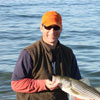5 New Ways to Approach Fall Trout Fishing
By Tom Keer
Sep 12, 2016
Change your approach when trout fishing in the fall and catch more fish.
The seasons change and so must we. Fall trout fishing is different from the spring and the summer for a number of reasons.
5 Fall Trout Fishing Points to Consider
1. Look for the perfect water temperature. When the water temperature is between 55-65 degrees, a trout processes one stomach-full of food per day. When it's higher or lower, they process that same stomach-full of food every four days. The summer heat is fading, so look for that perfect temperature for catching trout.
2. Big and small bait. You'll see big or small food when fall trout fishing. Terrestrials, land based insects that blow into the water are common food for trout. Crickets, ants, and grasshoppers are in that food group. Aquatic insects like Blue-winged olives and midges tend to be smaller, while Isonychia and White Flies are big. See what's in the water and give the trout what they want!
3. Meat eaters. Winter is approaching, so if insect hatches are minimal then trout will feed heavily on baitfish. Live bait, streamers and bucktails, and leeches and crayfish are the best trout bait in deeper runs and pools.
4. Don't rule out attractor fly patterns. Fish are trying to put on some calories, so they're aggressive. Bright, flashy spoons and spinners and colorful flies fire up trout. The flashy fly patterns might not have worked when the summer trout were selective, but give 'em a try in the fall. After a rain when the water clarity is murky is an excellent time to try this technique for catching trout.
5. Approach. Whereas hot days made fish sluggish and selective, the cooler water has them looking. Finesse techniques can often be replaced by more aggressive techniques for fall trout fishing, particularly if you're after bigger, trophy fish. Don't let those big fish school you, show 'em who is boss!
Fall is a magical time to be outside, trout fishing. In a few weeks the colors will begin to turn and the trout will light it up. If work took up your time, get a license and get on the water before the snow flies.
5 Fall Trout Fishing Points to Consider
1. Look for the perfect water temperature. When the water temperature is between 55-65 degrees, a trout processes one stomach-full of food per day. When it's higher or lower, they process that same stomach-full of food every four days. The summer heat is fading, so look for that perfect temperature for catching trout.
2. Big and small bait. You'll see big or small food when fall trout fishing. Terrestrials, land based insects that blow into the water are common food for trout. Crickets, ants, and grasshoppers are in that food group. Aquatic insects like Blue-winged olives and midges tend to be smaller, while Isonychia and White Flies are big. See what's in the water and give the trout what they want!
3. Meat eaters. Winter is approaching, so if insect hatches are minimal then trout will feed heavily on baitfish. Live bait, streamers and bucktails, and leeches and crayfish are the best trout bait in deeper runs and pools.
4. Don't rule out attractor fly patterns. Fish are trying to put on some calories, so they're aggressive. Bright, flashy spoons and spinners and colorful flies fire up trout. The flashy fly patterns might not have worked when the summer trout were selective, but give 'em a try in the fall. After a rain when the water clarity is murky is an excellent time to try this technique for catching trout.
5. Approach. Whereas hot days made fish sluggish and selective, the cooler water has them looking. Finesse techniques can often be replaced by more aggressive techniques for fall trout fishing, particularly if you're after bigger, trophy fish. Don't let those big fish school you, show 'em who is boss!
Fall is a magical time to be outside, trout fishing. In a few weeks the colors will begin to turn and the trout will light it up. If work took up your time, get a license and get on the water before the snow flies.
Popular Posts









